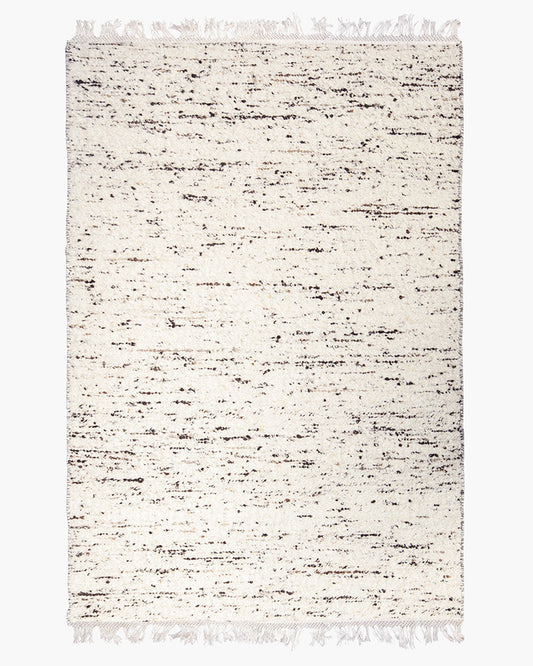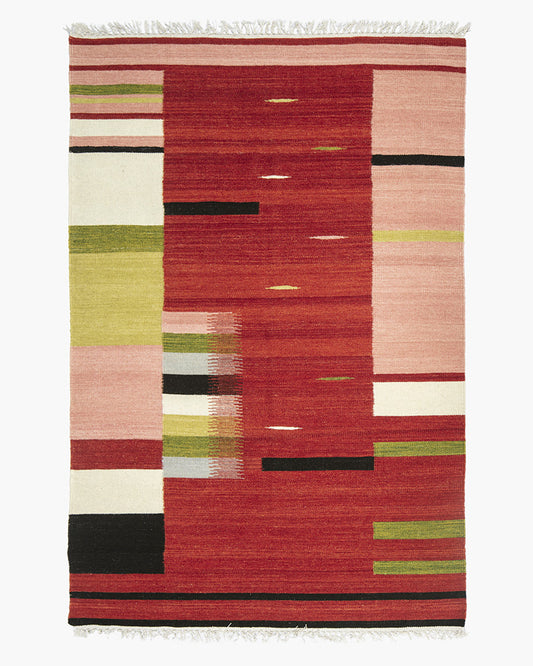Simone and I were first introduced by a mutual friend (and my then roommate) in Toronto back in 2015. We were both working in-house at various design studios around town. A lot has happened in the last nine years. Simone has since opened her own studio focused on interiors and object design and I’ve been lucky to have some of my rugs be featured in her projects. We have also been working on a product for Mark Krebs slotted to be released later this month.
I had the pleasure of sitting down with Simone to chat about her design studio and how material choices, finishes, and time create spaces rich with stories.

Photograph by Lauren Kolyn
Mark Krebs
How did you get started in design and what led to you opening your own studio?
Simone Ferkul
I began my journey in design about 12 years ago after graduating from Toronto Metropolitan University with a degree in interior design. Growing up in a household that encouraged creativity, I always knew I wanted to pursue a creative field. Design seemed like the ideal choice, offering a way to make a living while maintaining the flexibility to explore various interests.
This drive for exploration led me to establish my own studio. I observed that many interior design and architecture firms were highly specialized, often limiting their work to specific areas. Since I had interests in interiors, art, and objects, I wanted to create a studio that embraced a wider range of creative possibilities. That’s how my practice came to be.
MK
What do you think the role of an interior designer is exactly?
SF
I think the role of an interior designer, whether in residential or commercial design, is to tell the story of the client. For a home, it involves understanding their needs and how they want to express themselves. It’s also important to leave some space for the person to develop the space over time, especially in a home. The same applies to commercial spaces. If a client comes to me asking for a brand design in just a few weeks, I always say no. It’s such an involved process on both ends. First, it’s about building trust between the two parties, and then developing that trust into a spatial experience that reflects who the user is.
MK
Where do your projects usually start? I suppose there are two angles: one being self-directed and the other with clients. In general, how do you tend to approach a project?
SF
I always start with something I feel is missing and then explore how to develop it. I consider what it looks like, how it shapes the user’s experience, and proceed from there. Many people focus on visionary sessions with images and other guides. I think a step is often missed where, as the designer, you use your skill set to help guide people without relying solely on images.
I often start with sketching or mapping out the space and then use images to explain specific moments. However, I don’t rely on images to dictate the look and feel because that can come from the exploration of user needs.


Custom stools for Attic, photographs by Simone Ferkul and Riley Snelling
MK
Right. And that also ensures that neither you nor your clients are pushing towards creating a copy of an existing design. It’s something unique to each project.
SF
Yes, exactly. For some aspects, like explaining how a handle works, images are important. However, to maintain original concepts, it’s crucial to have a story and narrative that speaks to the user rather than being guided by images. Many people come to me with Pinterest boards of what they want their house to look like, and I tell them we need to dive into those images to understand what they truly want.
MK
Right, right. Here’s the Pinterest board of what I want my house to look like.
SF
Yes, and while that’s cool, what I often discover by the end of those sessions is that many of the images people gather don’t actually align with how they want their space to function. I find that interesting, especially because we live in such a visual culture.
MK
It’s almost like they’re their own worst enemy, choosing against their own interests because it looks nice in a photo.
SF
Yes, exactly.


Private Home and Biblio House, photographed by Riley Snelling, James Morley, and doublespace Architecture photo
MK
What are the through lines between product and environmental design for you? And when you're designing a product, do you imagine it in a specific space? Are you designing for the space, or is it kind of two different lanes?
SF
When you're designing the "box" that holds all of these objects, it’s about how those things come together to create the story of the space. In contrast, with objects, it’s more about how people gather or find objects that become part of their identity within the space. This is why I mentioned earlier that leaving room for growth is important. Many people want everything right away—like the couch, the vase, everything completed—but it’s crucial to allow clients to grow into the space. Otherwise, everything becomes too finite, and that can lead to things feeling dated over time. It’s like you’ve figured everything out, and then you’re locked into it.
MK
Now you're living in a 90s hotel room or something.
SF
Exactly. There’s a fear of replacing an object or refocusing the space. From an object standpoint, I find it interesting because it’s almost the opposite of interior design. In interior design, you take all these objects to figure out the story. When designing an object, you’re putting it out into the world for people to add to their story. There’s an exciting unknown about where an object might end up. For example, with a planter I designed years ago, I still get texts from friends and acquaintances about it being in the most random locations around the world.

Photograph by Lauren Kolyn
MK
Yeah, I’ve seen it in many different places. The last time was in some random location, maybe an Airbnb or something. It pops up from time to time, and I always check to see if it’s branded on the bottom too, because it might be a knockoff.
SF
That’s the interesting part of approaching object design. It gives me a certain freedom because, often, with furniture or smaller-scale items I create, it starts from a problem I’m experiencing with a product that doesn’t exist. Letting it go after that is really rewarding.
MK
Unlike an interior where it’s a singular thing. Whatever happens in that space is either developing as you hoped or diverging from the original concept. With an object, it can exist in many places, but the object itself remains the same.
SF
Yes, and with interiors, there’s often an end story as the designer—you get the project photographed. The client might come back for furniture reselecting or updates, but with products, it’s more fast-paced and there’s a lot more variance. It’s like a continual story.
MK
Your work seems to center around material and finish. Solid white oak, paneling, and different stone surfaces in your projects. Can you elaborate on where this focus on material comes from?
SF
It's about taking simple materials and applying them in a way that changes the user's experience based on their location.
This goes for the project we just shot together, featuring your new gold colour in the Boucle rug. All the stones in that project were polished when we first selected them. I had to convince the client to trust me with the idea of honing the materials because I saw how they could change. There’s always a risk, and sometimes surprises happen, but even the granite used in the bathroom was an ugly '90s granite. When polished, it was very much back in that era. But when we honed it, it revealed light blues, golds, and burnt oranges that completely transformed the materiality in the space. Seeing that transformation was really rewarding.


Attic and Milky's, photographed by Riley Snelling
MK
Where do you see meaningful interior design and product design today, and what would you like to see at the forefront?
SF
It’s okay to incorporate vintage pieces within a space. Even in the project I just shot, the dining table is vintage. I think it’s about finding a fine balance between objects made with intention today and those made with intention 20 or 30 years ago to create a space that tells a story. One goal of my practice is to have something handmade by myself in every single project. We, as tactile people who are used to working with our hands, sometimes get too caught up in screens and forget the humanizing touch that finishes a project.
MK
Like a handmade rug?
SF
Yes, exactly. A handmade rug, a uniquely carved wood object—something that grounds design and moves it away from a purely technology-based world.
MK
Yeah, like how some interiors are now starting to look like renderings.
SF
Exactly. This approach can manifest in various ways. For me, it often involves working with makers to create custom furniture for a space, if the project budget allows. People want something uniquely theirs, and while working with makers can be more costly, the final product is often comparable to the high prices of big-box store items. It’s important for me to keep this aspect of design alive.


Private Home, photographs by Riley Snelling, James Morley, and doublespace Architecture photo
MK
OK, last question. F*** Marry, Kill the following architectural movements: Hyper Modernism, Brutalism, Rococo.
SF
Oh God. This is hard. This might be one of the hardest questions. OK, I’m going to kill Rococo. I’m going to marry Brutalism.
MK
And then have sex with Hyper-Modernism?
SF
[laughs] Yes, I guess I’m going to have sex with Hyper Modernism because there’s something very interesting about dabbling within this hyper-modernist world that feels very connected to design now. Rococo is so over-the-top that, as a designer, I don’t connect with it as much, so I can live without it. Brutalism, on the other hand, has interesting uses of materials. Although some find it cold, I actually find a lot of detail in Brutalism quite lovely. The details and the unexpected use of materials can add warmth, and it's not just about concrete—there are Brutalist spaces that use wood, leather, and other raw materials in intriguing ways.
MK
And as the gardens and trees grow around it and it settles in, it becomes much more interesting with age. I would marry Brutalism as well.
SF
Yeah, yeah.
MK
I’d have sex with Rococo—it seems like it would be a wild experience. Very uber-rich drug-fueled orgy. I’d kill Hyper Modernism because it feels soulless anyways.
SF
Fair enough! That was a fun question.
For more information about Simone Ferkul and her work, please visit simoneferkul.com and follow her on Instagram.

Biblio House, photographed by James Morley and doublespace Architecture photo




